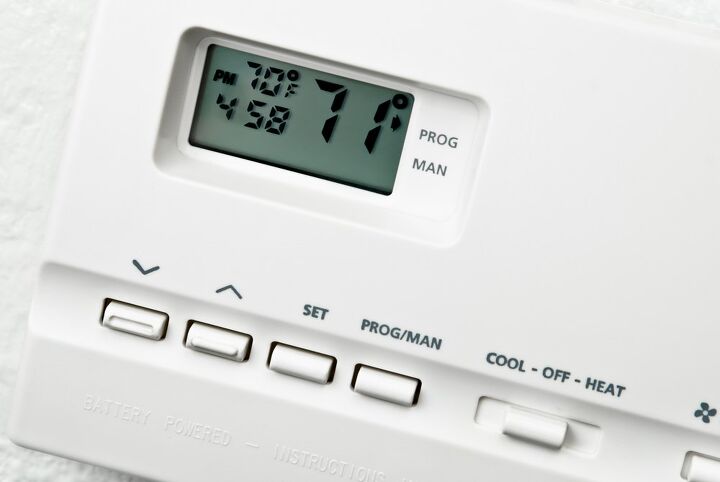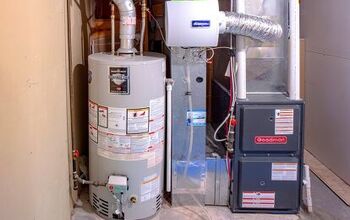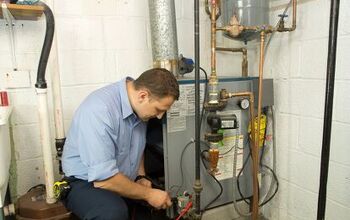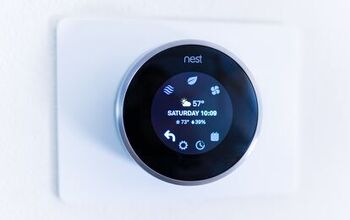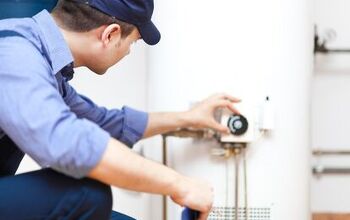Furnace Keeps Running But Thermostat Off? (Possible Causes & Fixes)

Your thermostat is meant to be the heart and brain of your HVAC system. That’s why it should almost always be on. I mean, come on. It’s what sends the signal to your heater and AC units. If there’s no signal, there shouldn’t be a heater running. So…why is yours still running while your thermostat is off?
If your furnace keeps running after you shut off your thermostat, check your fan limit switch. The fan limit switch may be stuck on “manual,” which means that your furnace fan will keep running even when the thermostat has no power. If the limit switch is blown, you also could end up with a continually running furnace.
Seeing your furnace running when it shouldn’t is alarming. We can’t mince words about that. Here’s what you can make sure to do in order to avoid problems.
Do You Need Furnace or Heating System Repair?
Get free, zero-commitment quotes from pro contractors near you.

Before You Begin: Is Your Thermostat Really Off?
Believe it or not, there’s different types of “OFF” with a thermostat. If your thermostat has no power, then that’s totally off and probably means it’s your fan limit switch. With that said, we’re going to walk you through a bunch of reasons why your furnace doesn’t seem to want to turn off.
Wait To See If It’s Delayed Signals
First things first. If your thermostat isn’t turned off entirely and it just turned the heat off, calm down. It can take several minutes for your furnace to turn off once they get the signal. Give it 10 minutes and see if you can still hear the hum of the furnace. If you can (or if your thermostat has no power), you should move forward.
Check To See If Your Thermostat Is On Auto
If you have kids, there’s a chance that they probably started to mess with the thermostat. Is your thermostat switched to “ON” by accident? If so, you probably just need to switch it to “AUTO” or “OFF.” Then, you should see your thermostat fall into place.
This is a common issue that people who have kids can have. You’d be surprised at how common it is for kids to play around with the thermostat.
Is It Bad Temperature Sensors?
In order for your furnace to stop running, it needs to have a sensor say that you’ve reached the target temperature. Sometimes, your sensor will not work the way it will. So while you know it should read something along the lines of 73 degrees, your sensor might still think it’s colder.
If your thermostat is on but should be telling your thermostat to go off, it could be time to clean the area around your sensor. If you still notice that it’s not working correctly, you need to make a call to an HVAC tech to see what’s going on.
Why Is My Furnace Still Running When My Thermostat Is Off?
Your furnace probably isn’t really running. However, there are some issues that you might want to look for before you call the HVAC tech. These below can be the culprits, though there could be some other underlying issues that may contribute to this.
Bad Wiring
Believe it or not, there are cases where a shorted wire in the thermostat will cause your HVAC to act funky. While your thermostat might be “off,” a shorted wire can still occasionally send signals to a furnace. This leads to the furnace either continually running, or stop running altogether.
In some cases, this can also be an internal wire that is part of your house rather than your thermostat.
The Fan Limit Switch
Furnaces work by blowing heated air throughout your home, and for that, you have to have a blower fan. This fan has a limit switch that allows homeowners to determine how they control the fan. When you hear your furnace running, it’s usually the fan, not the furnace itself. So, this might be why you hear it “running.”
Let’s get back to the limit switch and the reason why you have a furnace running. The limit switch can either be switched from “MANUAL” or “AUTO.” These two settings make all the difference when it comes to how your furnace runs.
The “AUTO” setting means that your fan will automatically shut off when your thermostat shuts off power to your fan. However, if you have “MANUAL” on, then you manually have to turn off your fan if you want your furnace to stop running. If it’s on MANUAL, switch it to AUTO.
Bad Batteries
Believe it or not, some thermostats will stop sending signals to your heating system if they’re too low on juice to do it. In order to have your thermostat turn off after heating up your home, it has to shoot signals over to the furnace to tell it to shut off. If your thermostat’s batteries died, your HVAC system will continue to run the way it was before the batteries ran out.
Most of the time, it’s pretty easy to see if your batteries have gone kaput. Your thermostat screen will not be able to respond to anything. Oh, and you might have also gotten warnings about the low battery life from your thermostat. (Nest thermostats, for example, send a notification to your phone.)
Obviously, replacing the battery will fix this issue. Once the batteries are replaced, reset your thermostat and you should see an immediate improvement in your unit’s responsiveness and efficiency.
Is This A Dangerous Problem?
For the most part, you shouldn’t be too worried if you notice that your furnace keeps running if your thermostat is off. As long as your furnace is working well, the only real issue is that it could harm your electricity bill and make your home uncomfortable.
Though the overall consensus is that this will not be a serious threat, there’s always a chance that the electrical wiring is to blame. This means that you may have an electrical fire on your hands if you are too negligent. So while it’s not a serious threat, it’s still something to take care of ASAP.
When Should You Call An HVAC Technician?
Like with any other part of your heating and AC system, you can’t always do stuff on your own. Sometimes, it just makes more sense to call a professional to help you make your system work normally once more. These signs indicate that it’s time to find a repairman near you:
- You are unsure where your fan limit switch is or just don’t feel comfortable poking around your HVAC system. There’s something to be said about not having to go beyond your comfort level. Home improvement can be scary these days and if you’re really freaking out about it, it’s better to have a pro do it.
- There is reason to believe that your electrical grid has been affected. If you have a shorted wire in the walls, this can be a fire hazard.
- You are confused with the wiring or wiring labels that you’re supposed to have. I can totally understand this, as my vision makes it hard for me to see colors in a normal way most of the time. If you have a hard time with vision, this is a good time to call a handyman.
- You recently bought your thermostat and problems started to arise. Okay, with this case, don’t call an HVAC tech. Call the maker of your new thermostat to see if you can get a refund. You may have gotten a defective model and that means you just need to replace your thermostat.
- You are not sure how to open up your thermostat. This is more of a handyman issue, but it’s still a thing that may warrant a call to someone else.
Basically, the moral of the story is that you should ask for help if you think you need it.
Do You Need Furnace or Heating System Repair?
Get free, zero-commitment quotes from pro contractors near you.

Related Questions
How many years should a thermostat last?
Thermostats are made to be durable, and that means you should expect to see it last 10 years at the very least. With regular maintenance of your thermostat, you should be able to see it last at least 15 years. You should replace a thermostat if you notice signs of breakdown happening within the first five years, since this is usually a sign of a defect.
What is the healthiest temperature for a thermostat to be set at?
Throughout the year, your thermostat temperature should try to change with the weather. With that said, people tend to do best with warm, balmy weather. A thermostat range from 68 to 78 degrees has been seen as ideal in most studies. If you want to go for a little colder or warmer, that’s up to you.
How cold is too cold for a home’s temperature?
Every person’s preferences will differ, but there are several studies that suggest that temperatures below 63 degrees may be too rough on sensitive people. Colder temperatures can put people at risk of respiratory illness, lung irritation, dry skin, as well as hypothermia. When in doubt, use your personal discretion.

Ossiana Tepfenhart is an expert writer, focusing on interior design and general home tips. Writing is her life, and it's what she does best. Her interests include art and real estate investments.
More by Ossiana Tepfenhart



